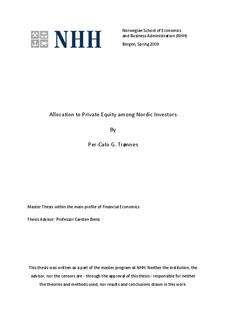| dc.description.abstract | Do Nordic investors allocate an optimal share of their portfolios to private equity? This study argues that they do, but there are many aspects that have to be considered that cannot be perfectly modelled. By finding an optimal portfolio and then comparing the actual allocation to private equity among limited partners, indications that they are allocating close to optimal can be found. The methods used for this purpose are two different analysis; mean variance analysis for finding an optimal portfolio and a survey among Nordic limited partners to find out more about how they are allocating. The mean variance analysis of a portfolio containing equity, bonds, and private equity shows that Nordic investors should invest between three and nine percent of their assets in private equity. Two different time periods have been used for the study to see differences; one from 1st January 1994 to 1st January 2009 and one ending one year earlier. For this study a relatively new type of private equity is used; listed private equity. The most challenging decision when including private equity is the choice of proxy, so that you can find data and returns that are comparable to other asset classes. With listed private equity daily market prices are available, and hence we do not have the same problems that we have with other measures of private equity with stale pricing and only quarterly data; not often traded and valuations are seldom updated.
By conducting a survey among Nordic institutional investors that have invested in private equity I find that they on average have allocated 4.8% to private equity; their target allocation is slightly higher at 6.1%. This indication of investors wanting to increase their allocations in the asset class is also seen from the fact that most limited partners will remain at the same allocation or increase it in the coming year. This place their allocation in-between the two different optimal portfolios found by using different time periods; the historical data gives very different future expected returns. Other findings from the survey includes: small buyout and secondaries will be popular investments in the coming year while large buyout and venture capital will be less popular, few of the limited partners use mean variance analysis as their main approach to determining their target allocation to private equity, and while many investors believe that fair value reporting from private equity funds is positive they also see negative sides to this form of valuation techniques. | en |
